
Navigation and Trajectory
10:00am-6:00pm, October 24 — December 13, 2015/ admission free
Noemi NIEDERHAUSER
ノエミ・ニーデルハウザー

All that remains is a haunted monologue.
4 videos (each 3 minutes, loop), Mixed media installation,
Clay mask, mushroom sculpture and stone arrow from the Jomon period lended by the Komakino Site Conservation Center (Aomori City Board of Education), size variable
photo: YAMAMOTO Tadasu
Creation of narratives conceived by misunderstandings and casting of a critical eye
HATTORI Hiroyuki
Noemi NIEDERHAUSER was studying psychology at university, but she felt uneasy about the lack of “working with (her) hands, touching material, creating out of them.”[1] As a unique contemporary artist, she went on to an art university and studied crafts, particularly learned ceramics practically. Her attitude to “deal with materials directly by hand,” which she has obtained from her experience of ceramic art is an important basis in Niederhauser’s creative activities even now. Later she further studied fine art in the postgraduate course at University of the Arts London’s Central Saint Martins, acquired conceptual methodologies as well as a variety of personal networks. With such extensive backgrounds, Niederhauser starts from the research in the geopolitical and historical characteristics and context of a certain place. While focusing on site-specific elements of the place, she follows a conceptual method, maintains craft-oriented intentionality and considers it important to create works calmly with her hands. Through such an approach, she creates peaceful spaces putting together various media including objects of her own making, fabric and moving images.
During this residency, she paid attention to the fact and details of a replica made to reproduce the large six-pillared building at Sannai Maruyama ruins. She created four fictional narratives regarding the six-pillared ruins and made them into installations. In the alcove at the entrance to the gallery is a piece of cloth printed with a Jomon man’s face with a bronze-like texture. On the other side of the glass door of the gallery are her installations. As if to avoid centrality or centripetal structure, each installation is displayed in the four respective corner of the exhibition room and the center of the room is a void. Each of the four installations has a video installed, and with videos and objects together, fictional narratives about the six pillars unfold. For the structure of each installation, rather than having a center or core, objects which are not large in size are placed here and there, and the wall is partially painted black at places. Some objects look like fictitious tools for some use. Each of the four narratives is treated equally without time sequence or difference in size of the scale. And the artist deals with each object of her own creation as if they were archaeological materials or artifacts. Soft objects of cloth like clothing are included in each installation. Some objects appear in the video as if in the nest of boxes. One mysterious woman appears in the video and sometimes plays with those objects. In the video images, for example, one image is divided many times and repeated, or ACAC buildings and scenery in the vicinity appear, so that a consistent narrative and a data-recording aspect of video are somewhat rejected. By vertically lining up elements of different timeframe, space and scale, her unique fantasy has been created.
The purpose and usage of constructing these six pillars at that time is not known even now, but Niederhauser got interested in the fact that the six-pillar building was reconstructed right beside its original archaeological site for the purpose such as tourism promotion. In fact, the idea of the form of the six-pillar ruins had been under discussion and the present form was decided as a result of aggregating some of the opinions. As the replica with a floor but without a roof has a strange structure somewhat different from the way of natural architecture, it looks more like a fictional creation rather than a faithful reproduction of the circumstances at that time. What is intricately incorporated there is the issue of authenticity and relationship between reality and fiction, and what is already latent is such creativity as similar to the artist’s act in reaction to the real situation, and it was closely akin to Niederhauser’s methodology of crafting artworks. She reconstructed a relationship between reality and reality-recording documentaries, and extracted four identities that this ruin might have had: a ritual site, watchtower, lighthouse and place for sensing climatic and seasonal changes. Then she created four stories related to them using objects and videos. Not revealing the correspondence between the narrative and the installation intentionally, the artist makes viewers imagine the relations themselves with the objects and videos as clues. They have to connect the pieces of narratives presented by Niederhauser to speculate like an archaeologist. The scallop-shaped object installed with a lens capturing inverted scenery in the center looks like a tool to predict the climate or to see the far distant landscape with lighthouse functions.
Niederhauser takes an attitude that putting cultural and social situations of a certain age into the realms of fantasy through misunderstandings and misinterpretations is already an artistic creation, and behind it is a highly conceptual and interesting thinking. Also it could be a sharp and critical eye at the essence of art and creation. This space filled with tranquility and mysterious atmosphere is where viewers themselves can create narratives, which might have happened by picking up, collecting and connecting a series of fictional archaeological fragments presented by Niederhauser. There, viewers would want to question once again about creative activities of art and its values.
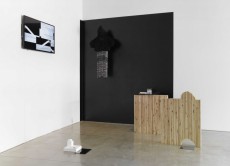
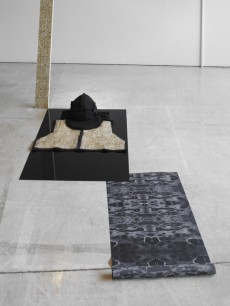
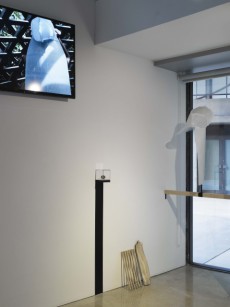
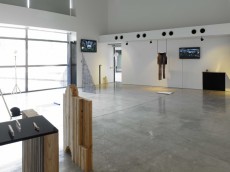
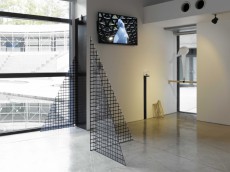
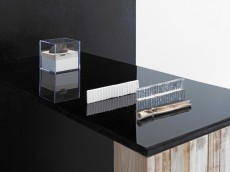

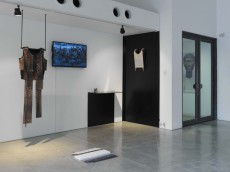

航行と軌跡
2015年10月24日(土)~12月13日(日)10:00-18:00/会期中無休・入場無料
ノエミ・ニーデルハウザー
Noemi NIEDERHAUSER

《All that remains is a haunted monologue》(唯一残るのは、憑かれた独白である。)
4つのビデオ作品(各約3分、ループ)、ミクストメディア、縄文時代の土偶、きのこ形土製品、石鏃(青森市教育委員会蔵)、サイズ可変
撮影:山本糾
掛け違いが生む物語の創作と批評的眼差しのあらわれ
服部浩之
ノエミ・ニーデルハウザーは、大学で心理学を学んでいたが、「自らの手で具体的な素材に触れなにかを生み出す」という感覚の欠如に違和感を覚え[i]、美術大学に進学し工芸、とくに陶芸を実践的に学んだユニークな背景を持つ現代美術家だ。陶芸の経験から得た「自らの手で直接素材を扱う」態度は、現在もニーデルハウザーの創作活動において重要なベースとなっている。また、その後ロンドンのセントラル・セントマーチンズ芸術大学大学院でファインアートを学び、コンセプチュアルな方法論を習得し、同時に多彩な人脈も獲得していく。このような背景からニーデルハウザーは、ある土地の地政学的・歴史的特質や文脈などのリサーチを起点に、その場所ならではのサイトスペシフィック性を重要視し、同時にコンセプチュアルな方法に則りつつも、工芸的指向性を保ち自身の手から淡々と作り出すことを大切にすることで、独自のオブジェクトやファブリック、映像など多様なメディアを組み合わせた静謐な作品空間を生み出す。
本滞在制作においては、三内丸山遺跡に六本柱の大型掘立柱建築がレプリカとして再建された事実やその経緯に焦点をあて、六本柱の遺構に関する四つの架空の物語を創作し、それをインスタレーションへと展開していった。展示室入口アルコーブ部分には、ブロンズのような質感で表現された縄文人の顔を印刷した一枚の布が掛けられ、ガラス扉の先の展示室にインスタレーションが展開される。中心性や求心的構造を避けるかのように、展示室の四つの角から各物語を形成するインスタレーションが展開され、中央部は不在のヴォイドを成している。四つのインスタレーションにはそれぞれひとつずつ映像が配置され、映像とオブジェクトを交えて六本柱に関する架空の物語が展開される。各インスタレーションの構成においても、中心となるものや核があるというより、あまり大きくないオブジェが散り散りに配置され、ときに壁面は部分的に黒く塗装されている。またいくつかのオブジェはなんらかの用途のための架空の道具のようにも見える。四つの物語は時間的連続性や、規模の大小の差異などはなく、等価に扱われている。そして、自身が制作するオブジェを考古学的資料や素材のように扱うのだ。また、布を用いた服のようなしなやかなオブジェも各インスタレーションに含まれている。いくつかのオブジェは映像の中にも入れ子的に出現する。映像にはひとりの謎めいた女性が現れ、時にそれらのオブジェと戯れる。映像中ではひとつのイメージが何分割もされ繰り返されたり、ACACの建物や近隣の風景が登場するなど、一貫した物語性や映像の記録的側面をある程度拒否し、時間も空間もスケールも全く異なる要素を垂直的に連ねることで独自のファンタジー化を実践している。
ニーデルハウザーは、この六本の柱が当時どのような目的で建立されたのか、その用途や目的が現在まで不明であるにも関わらず、その跡地のすぐ脇に観光プロモーションなどの目的のためにこの六本柱の構築物が再建された事実に興味を惹かれた。実際に六本柱の遺構の形態に関しては様々な議論がなされ、結果的にいくつかの意見を集約して現在のかたちになったという。屋根はないが床は存在するなど、自然な建築のあり方とはどこかずれた不思議な構成となったレプリカは、かつての状況を忠実に再現したというより、むしろフィクショナルな創作物とすら見えてくる。そこには、真贋の問題や現実とフィクションなどの関係がすでに複雑に織り込まれており、アーティストが現実の状況に対して起こす行為と似たような創作が既に内包されており、まさにニーデルハウザーの作品制作の方法論とも近しいものがあった。現実とそれを記録するドキュメントとの関係を再構築し、この遺構が備えていたかもしれない四つの特質として、祭祀の場、物見櫓、灯台、気候や季節の変化を感知するための場というアイデンティティを抽出し、それらにまつわる四つの物語をオブジェクトや映像を交えて生み出した。物語とインスタレーションの対応関係などを作家が意図的に明かさないことで、我々鑑賞者はオブジェや映像を手掛かりにその関係性すら自身で想像しなければならない。鑑賞者はニーデルハウザーから提示された物語の欠片を考古学者のようにつなぎ合わせ推測し、物語を自分で組み立て読み込んでいくのだ。例えば、反転した風景を取り込むレンズを中心にはめ込まれた帆立貝の貝殻のオブジェは、気候を占う道具のようにも思われるし、あるいは遠い彼方の風景を眺めるための灯台的機能を備えた道具とも捉えることができる。
ある時代の文化や社会の状況が、思い違いや間違った解釈によってファンタジー化されること自体が、既にアーティスティックな創作であると考えるニーデルハウザーの態度には、非常に概念的で興味深い思考法が背後に存在している。そしてそれは、アートや創作の本質に対する鋭い批評的な眼差しでもあるだろう。静けさとミステリアスな空気が充満するこの空間は、ニーデルハウザーが提示した一連の架空の考古資料的断片を拾い集めつないでいくことで、起こり得たかもしれない物語を我々観客自身が創作し、芸術や創造という営為とその価値について改めて問うてみたいと思わせる場であった。









